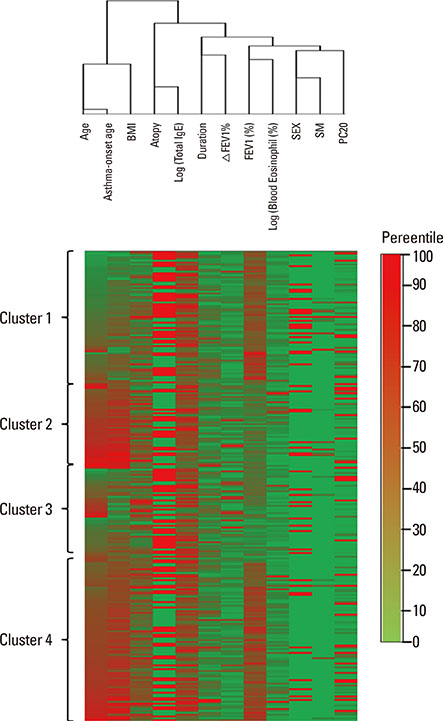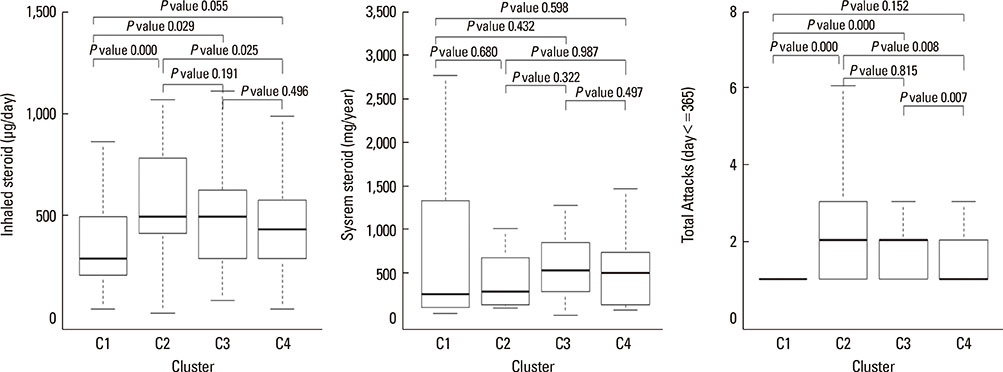Clinical Characteristics of Exacerbation-Prone Adult Asthmatics Identified by Cluster Analysis
- Affiliations
-
- 1Department of Pulmonology, Allergy and Critical Care Medicine, CHA Bundang Medical Center, CHA University, Seongnam, Korea.
- 2Genome Research Center for Allergy and Respiratory Diseases, Soonchunhyang University Bucheon Hospital, Bucheon, Korea.
- 3Division of Allergy and Respiratory Medicine, Department of Internal Medicine, Soonchunhyang University Bucheon Hospital, Bucheon, Korea. mdcspark@hanmail.net
- 4Division of Allergy and Respiratory Medicine, Department of Internal Medicine, Soonchunhyang University Seoul Hospital, Seoul, Korea.
- 5Department of Interdisciplinary Program in Biomedical Science Major, Soonchunhyang Graduate School, Bucheon, Korea.
- 6Department of Allergy and Clinical Immunology, University of Ulsan College of Medicine, Asan Medical Center, Seoul, Korea.
- 7Department of Allergy and Clinical Immunology, Ajou University School of Medicine, Suwon, Korea.
- 8Department of Internal Medicine, Hanyang University College of Medicine, Seoul, Korea.
- 9Department of Internal Medicine, Chung-Ang University College of Medicine, Seoul, Korea.
- KMID: 2421658
- DOI: http://doi.org/10.4168/aair.2017.9.6.483
Abstract
- PURPOSE
Asthma is a heterogeneous disease characterized by various types of airway inflammation and obstruction. Therefore, it is classified into several subphenotypes, such as early-onset atopic, obese non-eosinophilic, benign, and eosinophilic asthma, using cluster analysis. A number of asthmatics frequently experience exacerbation over a long-term follow-up period, but the exacerbation-prone subphenotype has rarely been evaluated by cluster analysis. This prompted us to identify clusters reflecting asthma exacerbation.
METHODS
A uniform cluster analysis method was applied to 259 adult asthmatics who were regularly followed-up for over 1 year using 12 variables, selected on the basis of their contribution to asthma phenotypes. After clustering, clinical profiles and exacerbation rates during follow-up were compared among the clusters.
RESULTS
Four subphenotypes were identified: cluster 1 was comprised of patients with early-onset atopic asthma with preserved lung function, cluster 2 late-onset non-atopic asthma with impaired lung function, cluster 3 early-onset atopic asthma with severely impaired lung function, and cluster 4 late-onset non-atopic asthma with well-preserved lung function. The patients in clusters 2 and 3 were identified as exacerbation-prone asthmatics, showing a higher risk of asthma exacerbation.
CONCLUSIONS
Two different phenotypes of exacerbation-prone asthma were identified among Korean asthmatics using cluster analysis; both were characterized by impaired lung function, but the age at asthma onset and atopic status were different between the two.
Keyword
MeSH Terms
Figure
Cited by 3 articles
-
Obesity-Associated Metabolic Signatures Correlate to Clinical and Inflammatory Profiles of Asthma: A Pilot Study
Ying Liu, Jing Zheng, Hong Ping Zhang, Xin Zhang, Lei Wang, Lisa Wood, Gang Wang
Allergy Asthma Immunol Res. 2018;10(6):628-647. doi: 10.4168/aair.2018.10.6.628.Characteristics of Adult Severe Refractory Asthma in Korea Analyzed From the Severe Asthma Registry
Min-Hye Kim, Sang-Heon Kim, So-Young Park, Ga-Young Ban, Joo-Hee Kim, Jae-Woo Jung, Ji Yong Moon, Woo-Jung Song, Hyouk-Soo Kwon, Jae-Woo Kwon, Jae Hyun Lee, Hye-Ryun Kang, Jong-Sook Park, Tae-Bum Kim, Heung-Woo Park, Kwang-Ha Yoo, Yeon-Mok Oh, Young-Il Koh, An-Soo Jang, Byung-Jae Lee, Young-Joo Cho, Sang-Heon Cho, Hae-Sim Park, Choon-Sik Park, Ho Joo Yoon, You Sook Cho
Allergy Asthma Immunol Res. 2019;11(1):43-54. doi: 10.4168/aair.2019.11.1.43.Innate Lymphoid Cells in the Airways: Their Functions and Regulators
Keisuke Orimo, Hirohisa Saito, Kenji Matsumoto, Hideaki Morita
Allergy Asthma Immunol Res. 2020;12(3):381-398. doi: 10.4168/aair.2020.12.3.381.
Reference
-
1. Global Initiative for Asthma. Global strategy for asthma management and prevention [Internet]. [place unknown]: Global Initiative for Asthma;2016. 2017 January 25. Available from: http://www.ginasthma.org/.2. Kim MA, Shin YS, Pham le D, Park HS. Adult asthma biomarkers. Curr Opin Allergy Clin Immunol. 2014; 14:49–54.3. Lemière C, Ernst P, Olivenstein R, Yamauchi Y, Govindaraju K, Ludwig MS, et al. Airway inflammation assessed by invasive and noninvasive means in severe asthma: eosinophilic and noneosinophilic phenotypes. J Allergy Clin Immunol. 2006; 118:1033–1039.4. Choi JS, Jang AS, Park JS, Park SW, Paik SH, Park JS, et al. Role of neutrophils in persistent airway obstruction due to refractory asthma. Respirology. 2012; 17:322–329.5. Jang AS, Lee JH, Park SW, Park JS, Kim DJ, Park CS. Risk factors related to fixed airway obstruction in patients with asthma after anti-asthma treatment. Ann Allergy Asthma Immunol. 2007; 99:408–412.6. Park CS. Eosinophilic bronchitis, eosinophilia associated genetic variants, and notch signaling in asthma. Allergy Asthma Immunol Res. 2010; 2:188–194.7. Haldar P, Pavord ID. Noneosinophilic asthma: a distinct clinical and pathologic phenotype. J Allergy Clin Immunol. 2007; 119:1043–1052.8. Fajt ML, Wenzel SE. Development of new therapies for severe asthma. Allergy Asthma Immunol Res. 2017; 9:3–14.9. Bousquet J, Cabrera P, Berkman N, Buhl R, Holgate S, Wenzel S, et al. The effect of treatment with omalizumab, an anti-IgE antibody, on asthma exacerbations and emergency medical visits in patients with severe persistent asthma. Allergy. 2005; 60:302–308.10. Bousquet J, Siergiejko Z, Swiebocka E, Humbert M, Rabe KF, Smith N, et al. Persistency of response to omalizumab therapy in severe allergic (IgE-mediated) asthma. Allergy. 2011; 66:671–678.11. Ortega HG, Liu MC, Pavord ID, Brusselle GG, FitzGerald JM, Chetta A, et al. Mepolizumab treatment in patients with severe eosinophilic asthma. N Engl J Med. 2014; 371:1198–1207.12. Corren J, Lemanske RF Jr, Hanania NA, Korenblat PE, Parsey MV, Arron JR, et al. Lebrikizumab treatment in adults with asthma. N Engl J Med. 2011; 365:1088–1098.13. Nair P, O’Byrne PM. Measuring eosinophils to make treatment decisions in asthma. Chest. 2016; 150:485–487.14. Hanania NA, Wenzel S, Rosén K, Hsieh HJ, Mosesova S, Choy DF, et al. Exploring the effects of omalizumab in allergic asthma: an analysis of biomarkers in the EXTRA study. Am J Respir Crit Care Med. 2013; 187:804–811.15. Izuhara K, Ohta S, Ono J. Using Periostin as a biomarker in the treatment of asthma. Allergy Asthma Immunol Res. 2016; 8:491–498.16. Wardzyńska A, Makowska JS, Pawełczyk M, Piechota-Polańczyk A, Kurowski M, Kowalski ML. Periostin in exhaled breath condensate and in serum of asthmatic patients: relationship to upper and lower airway disease. Allergy Asthma Immunol Res. 2017; 9:126–132.17. Wikipedia. Cluster analysis [Internet]. Los Angeles (CA): Wikipedia;2017. cited year month day. Available from: http://en.wikipedia.org/wiki/Cluster_analysis.18. Haldar P, Pavord ID, Shaw DE, Berry MA, Thomas M, Brightling CE, et al. Cluster analysis and clinical asthma phenotypes. Am J Respir Crit Care Med. 2008; 178:218–224.19. Moore WC, Meyers DA, Wenzel SE, Teague WG, Li H, Li X, et al. Identification of asthma phenotypes using cluster analysis in the Severe Asthma Research Program. Am J Respir Crit Care Med. 2010; 181:315–323.20. Sutherland ER, Goleva E, King TS, Lehman E, Stevens AD, Jackson LP, et al. Cluster analysis of obesity and asthma phenotypes. PLoS One. 2012; 7:e36631.21. Amelink M, de Nijs SB, de Groot JC, van Tilburg PM, van Spiegel PI, Krouwels FH, et al. Three phenotypes of adult-onset asthma. Allergy. 2013; 68:674–680.22. Kim TB, Jang AS, Kwon HS, Park JS, Chang YS, Cho SH, et al. Identification of asthma clusters in two independent Korean adult asthma cohorts. Eur Respir J. 2013; 41:1308–1314.23. Park SY, Baek S, Kim S, Yoon SY, Kwon HS, Chang YS, et al. Clinical significance of asthma clusters by longitudinal analysis in Korean asthma cohort. PLoS One. 2013; 8:e83540.24. Jang AS, Kwon HS, Cho YS, Bae YJ, Kim TB, Park JS, et al. Identification of subtypes of refractory asthma in Korean patients by cluster analysis. Lung. 2013; 191:87–93.25. Kim S, Kim Y, Lee MR, Kim J, Jung A, Park JS, et al. Winter season temperature drops and sulfur dioxide levels affect on exacerbation of refractory asthma in South Korea: a time-trend controlled case-crossover study using Soonchunhyang asthma cohort data. J Asthma. 2012; 49:679–687.26. Ball GH, Hall DJ. A clustering technique for summarizing multivariate data. Behav Sci. 1967; 12:153–155.27. Everitt BS. Cluster analysis. 3rd ed. New York (NY): John Wiley;1993.28. Rosi E, Ronchi MC, Grazzini M, Duranti R, Scano G. Sputum analysis, bronchial hyperresponsiveness, and airway function in asthma: results of a factor analysis. J Allergy Clin Immunol. 1999; 103:232–237.29. Miranda C, Busacker A, Balzar S, Trudeau J, Wenzel SE. Distinguishing severe asthma phenotypes: role of age at onset and eosinophilic inflammation. J Allergy Clin Immunol. 2004; 113:101–108.30. Proceedings of the ATS workshop on refractory asthma: current understanding, recommendations, and unanswered questions. American Thoracic Society. Am J Respir Crit Care Med. 2000; 162:2341–2351.
- Full Text Links
- Actions
-
Cited
- CITED
-
- Close
- Share
- Similar articles
-
- Association between primary immunodeficiency and asthma exacerbation in adult asthmatics
- Expression of glucocorticoid receptor beta in peripheral blood mononuclear cells of asthmatics experiencing exacerbation after upper respiratory infection
- Genetic Signatures of Acute Asthma Exacerbation Related With Ineffective Response to Corticosteroid
- Changes in Plasma and Urine Endothelin Levels During Acute Exacerbation of Asthma
- Effects of Immunoglobulin Replacement on Asthma Exacerbation in Adult Asthmatics with IgG Subclass Deficiency




